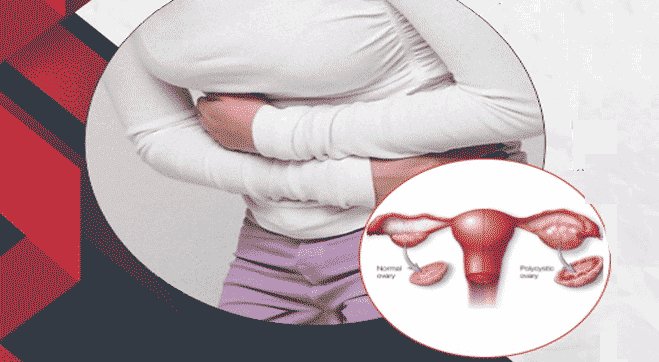Beauty is utmost precious to a woman, but some unresolved disorders like polycystic ovarian syndrome (PCOS), might manifest some unwanted features. PCOS is largely associated with reproductive morbidities including menstrual dysfunction, infertility and increased pregnancy loss. This disorder can be polycystic (multiple cysts on one or both ovary) or hyperandrogenic (excessive levels of androgens). The overproduction of androgens (i.e testosterone) and disordered gonadotropin secretions give rise to hirsutism, mood swings and sleep deprived nights. Increased secretion of androgens is either from adrenal glands or due to an ovarian disease. Little is known about it’s etiology, however, PCOS is an oligogenic disorder with complex interplay between genetic and environmental factors including metabolic syndrome, drug induction, or is simply idiopathic in nature.
PCOS is a multifaceted disease involving increased ovarian steroidogenesis, disturbed insulin secretions and excessive Polycystic ovarian syndrome oxidative stress. It is associated with an intrinsic defect in theca The word “polycystic” means “having many cells that secrete high levels androgens. Studies also show cysts” in the ovary, and is a condition that arises an elevated number of pre of-antral and small antral from hormonal imbalance in the body. PCOS was follicles which occur due to defect in the first reported in the year 1935 by Stein and apoptotic process in some maturating L eventhal and is also known as Stein-Leventhal follicles in females with PCOS.
Polycystic ovarian syndrome
The word “polycystic” means “havings many cysts” in the ovary , and is a condition that arises from hormonal
imbalance in the body. PCOS was first reported in the year 1935 by Stein and leventhal and is also known
as Stein-Leventhal Syndrome. It is a heritable disorder with autosomal dominant pattern of inheritance. It is
a leading endocrine disorder that affects around 7% of adult women and girls of child bearing age, Women
suffering from PCOS experience hyperandro genism, anovulation, menstrual irregularities or amenorrhea and
hirsutism. The irregular menstrual cycles often make it difficult for a women, suffering from PCOS to conceive.
Some other symptoms of the PCOS are pelvic pain, alopecia, acne, acanthosis nigricans (skin disorder)
and skin tags.
Causes of PCOS
- Anovulatory infertility-Anovulation is a pathognomic feature of PCOS that does not allow endometrial receptivity and leads to persistent menstrual irregularities or oligomenorrheoa. Apart from this, the presence of obesity and thyroid dysfunction also affect the ovulation process. Nonetheless, irrespective of the weight, PCOS patients are at increased risk of infertility.
- Arrested follicle development- Abnormalities in the granulosa and theca cells restrict the ability of early and mid antral stage follicles to respond against hormones like luteinizing hormone and follicle stimulating hormone, disrupt follicle development and arrest mid antral stage follicles.
PCOS Associated Comorbidities
Individuals with PCOS have higher risk of certain diseases. This exposes them to high morbidity and is also associated
with increased social and economic impact. They are more prevalent in
- Thyroid Dysfunction Rise in thyrotropin releasing hormones increases the secretion of Prolactin and thyroid stimulating hormone in hypothyroidism. Increase in prolactin hormone disturbs the ratio between FSH and LH, and increases dehydroepiandrosterone (DHEAS) from adrenal glands due to which ovulation gets restricted.
- Breast, Endometrial and Ovarian cancers In addition to infertility the alteration in the metabolic and hormonal environment among PCOS affected people promote occurence of neoplastic diseases.
- Cardiovascular diseases With aging conditions like hyperandrogenism, insulin resistance, dyslipidemia and inflammatory state present with peculiar hormonal pattern leading to increased risk of cardiac problems in PCOS women.
- Liver diseases Excessive fat deposition and insulin resistance normally seen in PCOS cases affects functioning of the liver and generate a risk of nonalcoholic fatty liver disease (NAFLD).
- Type 2 diabetes mellitus In PCOS cases, metabolic abnormalities like B-cell dysfunction and defective insulin action increase the risk of glucose intolerance and type 2 diabetes.
- Obesity In obese individuals, androgen clearance maintain circulating bioavailable androgen levels in normal range, but in PCOS, bioavailable androgen level gets increased. The condition is further worsened when sex hormone binding globulin levels are also reduced due to hyperinsulinemia.
Hirsutism
Among various endocrine disorders, PCOS is the most common cause of hirsutism and is present in 92% of
women with idiopathic hirsutism. The excessive coarse hairy growth in masculine pattern is termed as
Hirsutism. It is due to hyperandrogenism and has a huge psychosocial impact on young females. It is different
from hypertrichosis that involves a more uniform and evenly distributed pattern of hair on entire body. In
Hirsutes, abnormal hair are generally seen on upper lip, chin, chest, upper abdomen and back.
Causes of Hirsutism
Today, this condition is seen in 5-15% of women. Considered as an aesthetic problem, it is broadly divided into
androgen and non-androgen induced. Nonandrogenic causes of hirsutism are less as compared to androgenic.
Hirsutism can be decreased by suppressing the excess androgen production with combined oral contraceptives,
(OCPs) and statins therapy. Statins are well known to reduce the levels of testosterone.
Assessment of Severity
The severity of hirsutism is determined by FerrimanGallwey score which reveals the amount of distress caused
to the patient. Ferriman and Gallwey in 1961, developed a standard Ferriman-Gallwey (mFG) scoring system
that is based on visual examination and defines hirsutism quantitatively. The mFG score greater than or equal
to 8 is considered as hirsutism. Hirsutism can be mild, moderate or severe. It can be treated by nonpharmacological
methods and oral contraceptives. Clinically antiandrogens are also recommended for treatment purposes.
Role of Genetic and Environmental factors
The interaction between genetic and environmental factors exacerbate the disease. Genetically inherited genes
express themselves in progeny and in the presence of comorbidities, the management becomes problematic.
Environmental factors like obesity, due to poor dietary choices and physical inactivity make the condition much
worse.
An Unenviable relation: PCOS and Hirsutism
Hirsutism is thought to be related to disorders in peripheral androgen activity. It is a difficult problem to address,
especially for adolescents. PCOS and idiopathic hirsutism account for 90% of the hirsutism in women. The
increased production of hair follicles is attributed to circulating androgens, 80% of which are produced by
either ovaries or adrenals. Small amounts are also derived from androstenedione and DHEA in liver, skin
and adipose tissue.
Diagnostic Approaches
Due to the heterogeneity, PCOS is challenging to diagnose. The aim of diagnosis is to measure the free
testosterone or free androgen index, oligomenorrhea reflective of oligo-ovulation or polycystic ovaries.
This can be done by either clinical, biochemical or radiographic evaluation.
Clinical assessment
It includes questions regarding patient’s pubertal history, menstrual history, family history focusing on
reproductive health and endocrine disorders, medications and cosmetic procedures (undertaken to treat
acne or hirsutism). A detailed physical examination includes
- Skin for hair loss, acne, hirsutism/Ferriman-Gallwey score
- Bimanual examination (for ovarian mass assessment)
- Elevated Body Mass Index
- Signs of hypertension
- Upper body muscle mass
- Tanner staging
- External genitalia
Laboratory Testing Blood tests are recommended for evaluation of the following
- Hyperandrogenemia by checking the levels of total testosterone or bioavailable testosterone,
- Thyroid stimulating hormone for thyroid dysfunction,
- Prolactin hormone to rule out hyperprolactinemia,
- Screening tests for metabolic abnormalities: glucose intolerance and hyperlipidemia.
Radiographic Evaluation Ultrasonography is done in patients with PCOS to determine the ovarian volume and morphology. It helps to determine the presence of enlarged ovary, number of cysts and endometrial abnormalities.
Management
Although, the exact cause of the PCOS is unknown, but efficient management and strong clinical support
by specific therapies can reduce the symptoms. In PCOS, controlling the androgen levels will improve
menstrual regularity and in turn prevent endometrial hyperplasia. The individuals with known comorbidities
like Diabetes, should ensure controlled glucose levels. Treatment adherence is essential for successful
restoration of normal body functions. Sensible recognition of the evident symptoms, like hirsutism as well
as its severity and the distress it causes to patients by physicians can reduce the obvious outcomes.
However, a thorough physical examination, medical history and Pathology Test are all necessary to identify
hirsutism and PCOS and should be followed by proper treatment and management.
Testing @ HealthcareOnTime
Thyrocare offers PCOD profile test for the detection of Polycystic ovarian syndrome at highly affordable rates,
using highly sensitive and automated technology.








